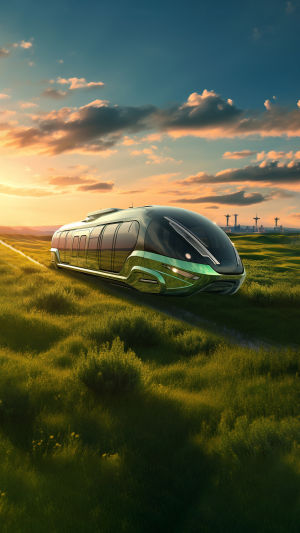In the realm of futuristic transportation, few concepts capture the imagination quite like the Hyperloop.
This groundbreaking technology promises to revolutionize how we travel by offering speeds up to 1,200 kilometres per hour, potentially transforming the landscape of global transportation.
Conceived by Elon Musk and initially proposed in 2013, the Hyperloop represents a bold leap into a future where travel is not only faster but also more efficient and sustainable.
At its core, the Hyperloop is a high-speed transportation system designed to carry passengers and cargo in low-pressure tubes. These tubes are typically elevated above the ground or built underground to minimize friction and external disturbances.
Inside these tubes, pods or capsules glide along a frictionless path using magnetic or air-based propulsion systems. The low-pressure environment within the tubes significantly reduces air resistance, enabling the pods to reach extraordinary speeds with minimal energy consumption.
The Hyperloop's design includes several key features that set it apart from conventional transportation methods. First, the system operates in a near-vacuum environment, which eliminates the majority of air resistance that traditional trains or planes face.
This allows the Hyperloop pods to maintain high speeds without expending excessive amounts of energy. Second, the use of magnetic or air-based propulsion systems further enhances efficiency and acceleration, contributing to the system's remarkable speed capabilities.
The Hyperloop's proposed speed of 1,200 kph (approximately 746 miles per hour) positions it as a game-changer in the realm of high-speed transportation. To put this into perspective, the Hyperloop could significantly cut travel time between major cities.
For instance, a trip from Los Angeles to San Francisco, which currently takes around 6 hours by car or 1 hour by plane, could potentially be completed in just 30 minutes by taking the Hyperloop.
This dramatic reduction in travel time could reshape how people think about distances and commuting, making it feasible to work in one city while living in another or to enjoy weekend trips across states or countries with ease.
The efficiency of the Hyperloop extends beyond its speed. The system's low energy consumption and minimal environmental impact make it a highly sustainable transportation option. By reducing the reliance on fossil fuels and lowering carbon emissions, the Hyperloop aligns with global efforts to combat climate change and promote cleaner energy sources.
Additionally, the system's reduced noise pollution compared to traditional trains or aeroplanes could contribute to a more peaceful and pleasant travel experience.
Despite its promising potential, the Hyperloop faces several challenges that need to be addressed before it becomes a mainstream mode of transportation.
One of the primary obstacles is the construction of vacuum-sealed tubes, which require advanced materials and engineering techniques to ensure safety and durability. The cost of developing and implementing Hyperloop infrastructure is substantial, posing financial and logistical hurdles for proponents of the technology.
Another challenge is achieving regulatory approval and public acceptance. As with any new transportation system, the Hyperloop must navigate a complex landscape of regulations, safety standards, and public perception.
Ensuring that the technology meets rigorous safety requirements and gains widespread support will be crucial for its successful deployment.
Despite these challenges, significant progress has been made in the development of the Hyperloop. Various companies and organizations, such as Virgin Hyperloop and Elon Musk's The Boring Company, have been working on prototype systems and testing technologies that bring the concept closer to reality. Test tracks have been built, and preliminary trials have demonstrated the feasibility of the Hyperloop's design and performance.





